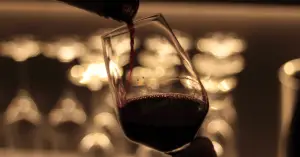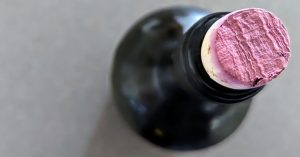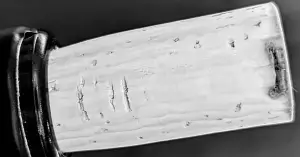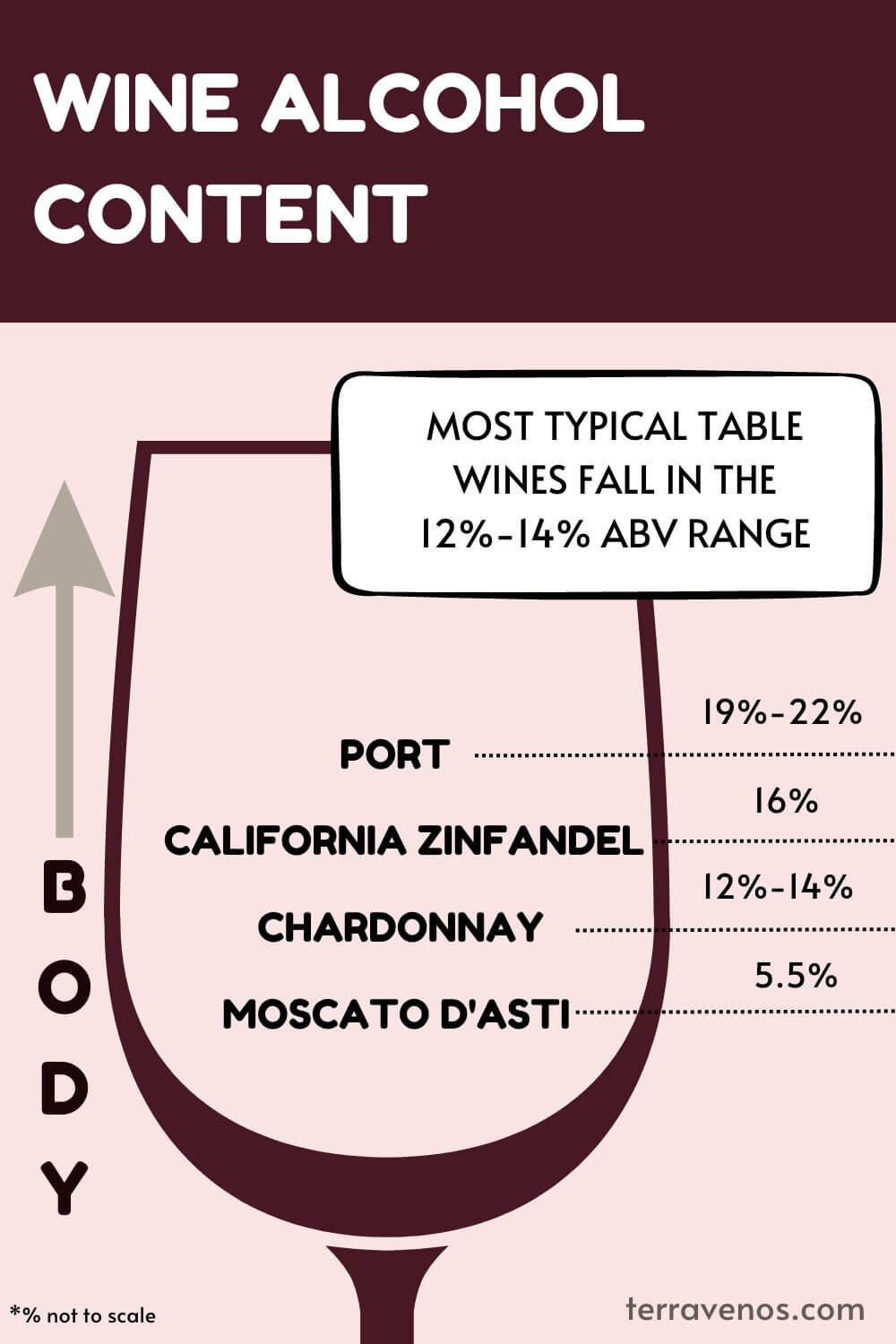
If you’re trying to figure out just the alcohol content in wine, then you’re in the right place. I’ve put together this general overview to get you started with alcohol content in different wines.
Step 1: Grab a bottle of wine and find the ABV or alcohol by volume.
Step 2: Grab another bottle and find the ABV on that bottle. They should be different (unless you have 2 of the same bottle).
- What Is ABV and How Is it Measured in Wine?
- Why Are Some Wines Higher in Alcohol?
- Alcohol Content in White Wine
- Red Wine Alcohol Percentage
- Alcohol Content in Sparkling Wine
- Alcohol Content in Rose Wine
- Alcohol Content in Fortified Wine – Stand Back, Baby!
- Is Wine Getting More Alcoholic?
- Percentage of Alcohol in Wine vs Sake
- Percentage of Alcohol in Wine vs Sake
- Alcohol in Wine Compared to Spirits
What Is ABV and How Is it Measured in Wine?
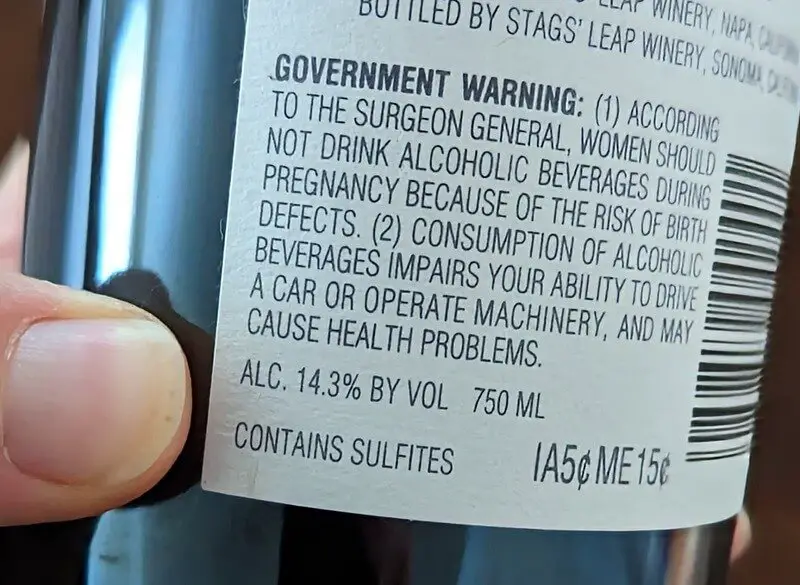
ABV, or Alcohol by Volume, in wine – it’s like the secret ingredient that adds a little kick to your favorite bottle. But what exactly does ABV mean, and how do we measure it?
When you see ABV, it means that the percentage listed is how much of the total volume is alcohol, in this case ethanol.
So if a wine has 12% alcohol by volume (12% ABV), then 12% of that 750 ml bottle is ethanol (about 90 ml).
When you spot ABV on a wine label, it’s like a little clue about the wine’s strength. It’s a percentage that tells you how much alcohol is in your bottle. Below, you’ll find five charts of alcohol level in common wine styles:
- Alcohol in White Wines
- Alcohol in Red Wines
- Alcohol in Rose Wines
- Alcohol in Sparkling Wines
- Alcohol in Fortified wines
- Alcohol in Wine vs Beer
- Alcohol in Wine vs Sake
- Alcohol in Wine vs Spirits
Why Are Some Wines Higher in Alcohol?
The level of alcohol in wine is directly proportional to the amount of sugar in the grapes before fermentation. Riper grapes mean more sugar. More sugar means higher alcohol wines. Hot regions produce higher-sugar berries that ferment into higher alcohol wines (e.g., Paso Robles).
Helpful Tip: Here’s everything you need to know about wine fermentation and how it works.
How Does Alcohol Level Affect How Wine Tastes?
One of the things about alcohol in wine that usually surprises people when I tell them is that alcohol is tied to body in wine.
Fun Wine Facts:
Lower-alcohol wines are lighter in body.
Higher alcohol wines are fuller-bodied.
Higher alcohol wines will also burn more and heat up your chest. Something to keep in mind on a cool winter’s night by the fire.
Helpful Tip: Here’s a guide that will help you figure out how to read a wine label.
Alcohol Content in White Wine
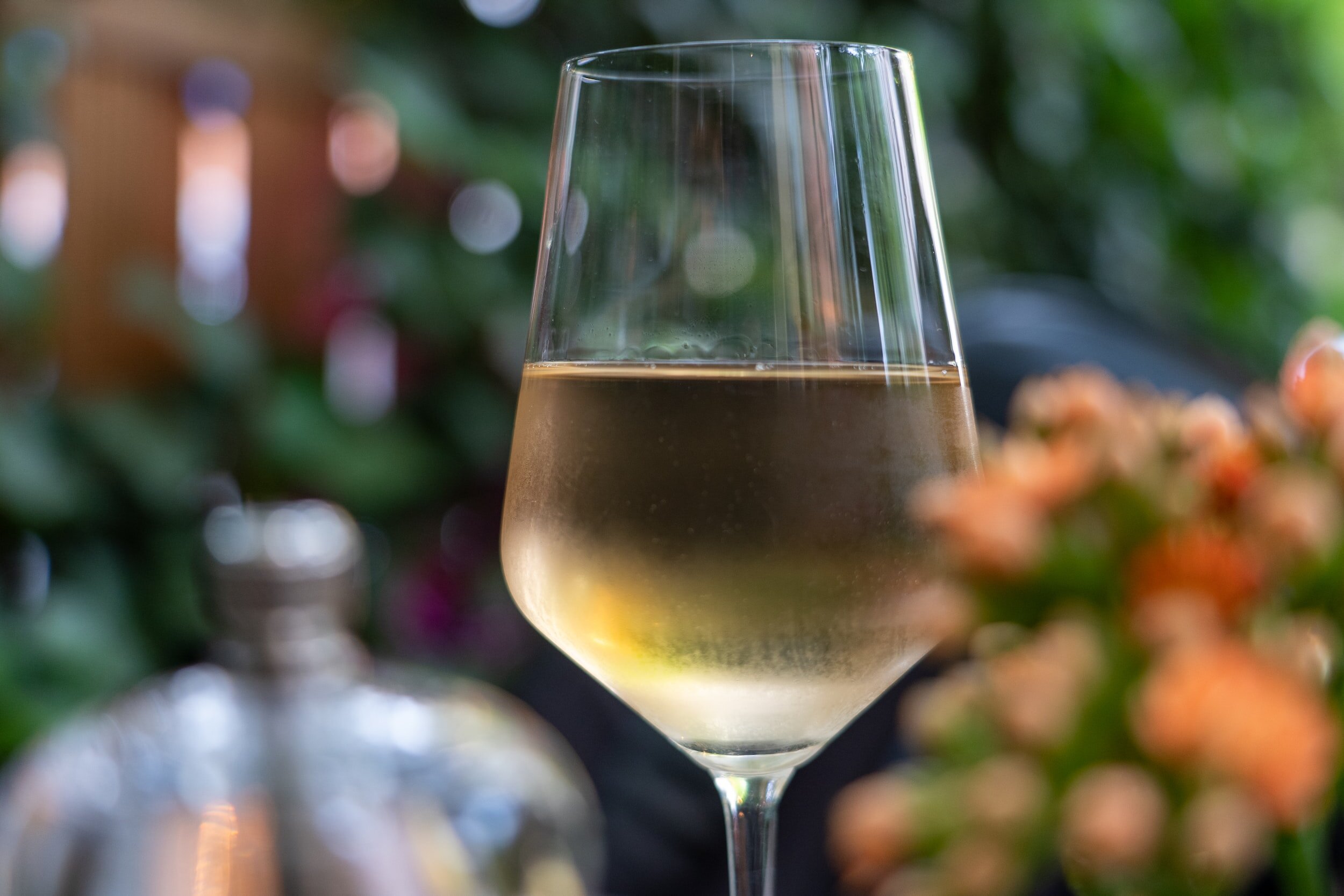
White wines vary in alcohol levels, typically ranging from around 9% to 14.5% ABV.
Many white wine lovers appreciate the lighter side of white wines, seeking a crisp and refreshing drinking experience, but you can find high alcohol whites as well.
| White Wine | ||
|---|---|---|
| Wine Name | Alcohol Range (ABV) | Country of Origin |
| Moscato d’Asti | 5-7% | Italy |
| Vinho Verde | 9-11% | Portugal |
| Riesling | 9-12% | Germany |
| Chenin Blanc | 9-13% | France, South Africa |
| Albariño | 11-13% | Spain |
| Grüner Veltliner | 11-14% | Austria |
| Vermentino | 11-14% | Italy, France |
| Pinot Grigio/Pinot Gris | 11-14% | Italy, France |
| Sauvignon Blanc | 11-14% | France, New Zealand |
| Torrontés | 11-14% | Argentina |
| Gewürztraminer | 12-14% | Germany, France |
| Gavi | 12-14% | Italy |
| Verdicchio | 12-14% | Italy |
| Viognier | 12-14% | France |
| Chardonnay | 12-14.5% | France, USA, Australia |
| Pinot Blanc | 12-14.5% | France, Germany |
| White Burgundy | 12-14.5% | France |
| Condrieu | 13-14.5% | France |
| Fiano | 13-14.5% | Italy |
| Viura/Macabeo | 13-14.5% | Spain |
| Chablis | 13-14.5% | France |
| Sancerre | 13-14.5% | France |
| White Hermitage | 13-15% | France |
| Sémillon | 12-15% | France, Australia |
| Marsanne | 12-15% | France |
| Roussanne | 12-15% | France |
| White Rioja | 12-15% | Spain |
Red Wine Alcohol Percentage
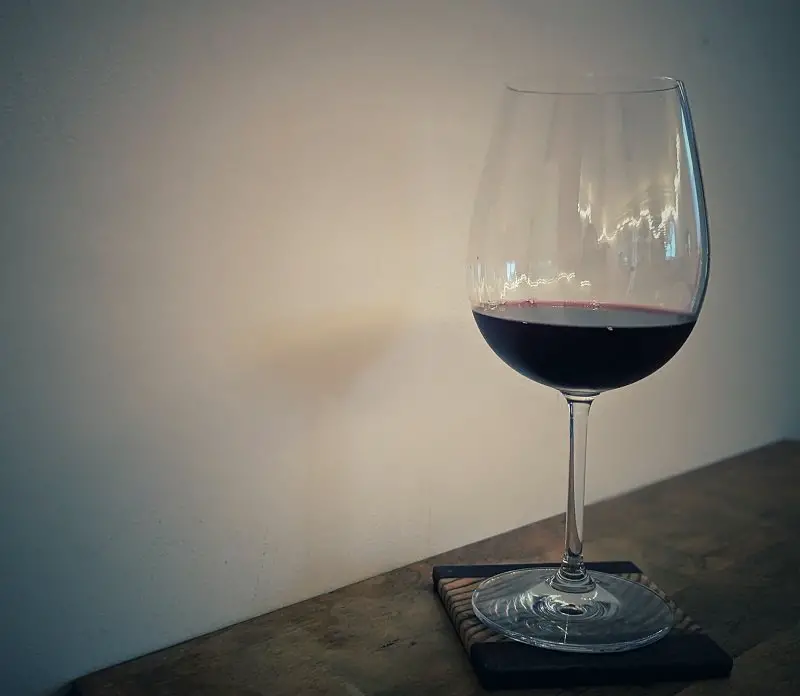
Check out this list of alcohol in red wines. You’ll find lighter red wines, like Beaujolais Nouveau, all the way to Sagrantino and tannic Tannat. Friendly
Tip: Remember, alcohol level corresponds to grape ripeness. Warmer growing regions have riper fruit with jammier aromas and flavors.
How does this affect your wine drinking experience? Example:
- Wine A: A Cabernet Sauvignon wine made in a cool region, like Haut Medoc, during a mild summer maybe has 12.5% ABV and will have flavors of under-ripe black currant green bell pepper notes.
- Wine B: A Cabernet Sauvignon made from grapes grown on a western-facing slope in Paso Robles get full afternoon sun. The wine will express jammy blackberry, black currant, and mint and has an ABV of 14.8%.
By looking at the percentage of alcohol in red wine, you can start to figure out how your red wine is going to present itself in your glass. It’s a little clue.
| Red Wine | ABV Range | Country |
|---|---|---|
| Beaujolais Nouveau | 11-13% | France |
| Bardolino | 11-13.5% | Italy |
| Gamay | 11-13.5% | France |
| Valpolicella | 11-14% | Italy |
| Zweigelt | 11-14% | Austria |
| Dolcetto | 11-14.5% | Italy |
| Pinot Noir | 11-14.5% | France, USA, New Zealand |
| Barbera | 11-14.5% | Italy |
| Grenache/Garnacha | 11-15% | France, Spain |
| Cinsault | 12-13.5% | France |
| Carignan | 12-14% | France, Spain |
| Sangiovese | 12-14% | Italy |
| Frappato | 12-14% | Italy |
| Merlot | 12-14.5% | France, USA |
| Tempranillo | 12-14.5% | Spain |
| Syrah/Shiraz | 12-15% | France, Australia |
| Cabernet Franc | 12-15% | France, USA |
| Malbec | 13-15% | Argentina |
| Xinomavro | 13-15% | Greece |
| Zinfandel | 13-16% | USA, Italy |
| Cabernet Sauvignon | 13-16% | France, USA, Chile |
| Amarone della Valpolicella | 14-16% | Italy |
| Petite Sirah/Durif | 14-16% | USA, France, Australia |
| Tannat | 14-16% | Uruguay, France |
| Sagrantino | 14-16% | Italy |
Alcohol Content in Sparkling Wine

The alcohol level in sparkling wine tends to be lower than in dry wines. Sparkling wines do best with just-ripe grapes from cooler growing regions, like Champagne.
Here’s a list of sparkling wines and their corresponding percentage of alcohol.
| Sparkling Wine | ||
|---|---|---|
| Wine Name | Alcohol Range (ABV) | Country of Origin |
| Asti Spumante | 7-9.5% | Italy |
| Lambrusco | 8-12% | Italy |
| Prosecco | 11-12% | Italy |
| Crémant | 11-12.5% | France |
| Champagne | 11.5-12.5% | France |
| Cava | 11.5-12.5% | Spain |
| Franciacorta | 11.5-13% | Italy |
| Sekt | 11.5-13% | Germany |
| Sparkling Rosé | 11-13% | Various regions |
| English Sparkling Wine | 11-13.5% | England |
Helpful Tip: Go explore Does Champagne have sugar, here.
Alcohol Content in Rose Wine
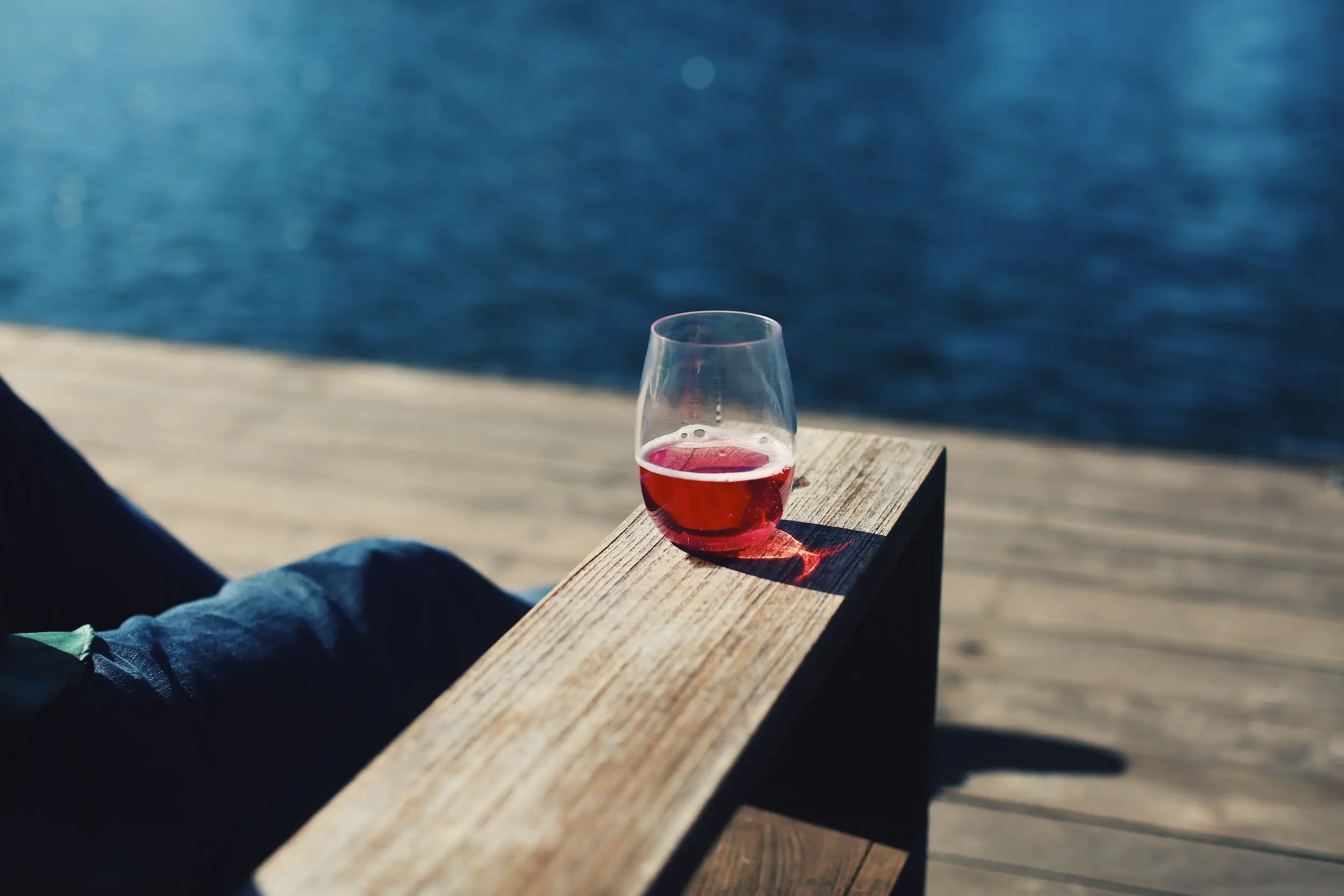
Rosé wines generally have a lower alcohol content compared to red or white wines, typically ranging from 9% to 14.5% ABV.
The lighter alcohol level in rosé wines contributes to their lighter body, and refreshing, and easy-drinking style.
The lower alcohol content also helps maintain a balanced and delicate profile that pairs well with casual sipping, appetizers, and lazy afternoons.
| Rose Wine | ||
|---|---|---|
| Wine Name | Alcohol Range (ABV) | Country of Origin |
| White Zinfandel | 9-11% | United States |
| Provence Rosé | 11-13% | France |
| Côtes de Provence Rosé | 11-13% | France |
| Rioja Rosado | 12-14% | Spain |
| Pinot Noir Rosé | 12-14% | Various regions |
| Grenache Rosé | 12-14.5% | France, Spain |
| Tavel | 13-14.5% | France |
Helpful Tip: Get started with rose wines here.
Alcohol Content in Fortified Wine – Stand Back, Baby!
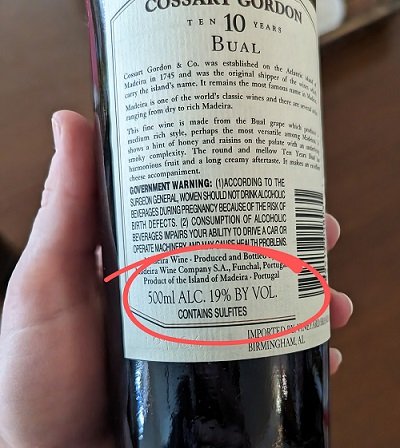
Fortified wines are a type of wine that’s been fortified with additional alcohol, typically in the form of grape spirits, such as brandy or aguardente.
Adding extra alcohol increases the wine’s overall alcohol content and to preserve it – historically for long voyages.
Adding the spirit not only raises the ABV (alcohol by volume) of the wine but also adds unique flavors and aromas, resulting in a distinctive experience.
Helpful Tip: I love fortified wines. Head over to Fortified vs Unfortified What’s the Difference to discover more.
| Fortified Wine | ||
|---|---|---|
| Wine Name | Alcohol Range (ABV) | Country of Origin |
| Pedro Ximénez | 15-17% | Spain |
| Banyuls | 15-17% | France |
| Vin Santo | 15-17% | Italy |
| Maury | 16-17% | France |
| Sherry | 15-20% | Spain |
| Marsala | 15-20% | Italy |
| Commandaria | 15-20% | Cyprus |
| Madeira | 18-20% | Portugal |
| Port | 19-22% | Portugal |
Is Wine Getting More Alcoholic?
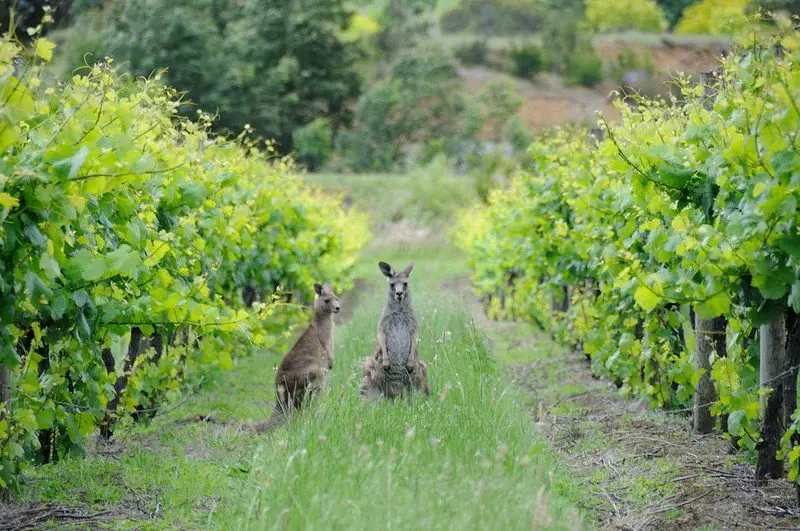
Yes, wine is becoming more alcoholic. Regional weather patterns around wine-growing regions have been trending upwards, leading to riper grapes that accumulate more sugar.
More sugar in the grape means more alcohol.
Rising temperatures are changing the profiles of iconic wines in some of the world’s most traditional winegrowing regions, from Bordeaux to Burgundy. Most recently, Bordeaux approved the expansion of permitted grapes to include the Portuguese red grape, Touriga Nacional, which is heat-loving blockbuster.
Other changes include planting vineyards at higher (cooler) elevations, and modifying vineyard practices, like modifying pruning to maximize airflow or installing irrigation.
Percentage of Alcohol in Wine vs Sake
| Wine vs Beer | ||
|---|---|---|
| Drink | Alcohol Range (ABV) | Country of Origin |
| Wine | 5-15% | Various regions |
| Beer | 2-10% | Various regions |
Percentage of Alcohol in Wine vs Sake
| Wine vs Sake | ||
|---|---|---|
| Drink | Alcohol Range (ABV) | Country of Origin |
| Wine | 5-15% | Various regions |
| Sake | 15-20% | Japan |
Alcohol in Wine Compared to Spirits
| Wine vs Spirits | ||
|---|---|---|
| Drink | Alcohol Range (ABV) | Country of Origin |
| Wine | 5-15% | Various regions |
| Vodka | 40-50% | Various regions |
| Whisky | 40-60% | Various regions |
Thirsty for More?
Go explore how alcohol affects wine.
Here’s a helpful list of light red wines (if you’re not into the big reds).
And if you do like big and bold reds, here’s a post on strong red wines just for you.
I put together this quick overview of 11 classic wine growing regions around the world and their signature grapes any budding wine-lover should know.

